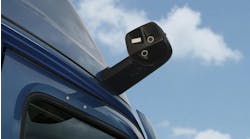Advanced driver assistance systems—think automatic emergency braking, adaptive cruise control, active lane-keeping functions, and lane-departure warning systems—were invented to reduce human errors and ultimately decrease the number of accidents on the road. But before these systems find their footing and are widely accepted among commercial truck fleets and drivers, certain misconceptions and driver frustrations must be resolved.
The Virginia Tech Transportation Institute has been investigating and researching the various technical and market barriers that are limiting fleets’ adoption of ADAS technologies today. Technical barriers, according to Matt Camden, senior research associate for VTTI’s Center for Truck and Bus Safety, typically center around the engineering and technical aspects of a technology’s ability to function as intended—whereas market barriers tend to focus on the factors that impact the acceptance of the technology.
“This could be more along the lines of how fleets and drivers accept the technology and use it,” Camden said during a webinar hosted by Partners for Automated Vehicle Education, the Federal Motor Carrier Safety Administration, and the Tech-Celerate Now program. “There are certain aspects of false alerts or a lot of driver warnings that could impact the market barriers.”
FMCSA launched its Tech-Celerate Now program in February 2020 with an objective to explore the understanding and adoption of current ADAS technologies, as well as education and assessment of future ADAS technologies. The program is a partnership with FMCSA and industry groups including American Trucking Associations’ Technology & Maintenance Council, the American Transportation Research Institute (ATRI), and the Owner-Operator Independent Driver Association (OOIDA).
Tech-Celerate intends to release an ROI calculator to help the trucking industry understand what the inputs and outputs are when adopting ADAS technologies.
The first order of business, however, will be identifying impediments. “If you don’t resolve misunderstandings, misperceptions, and concerns, we don’t have a lot of opportunity to move forward with adoption,” explained Dan Murray, vice president of ATRI.
Looking at published research and what the industry has said so far regarding challenges to ADAS adoption, VTTI researchers drafted a list of potential barriers. Based on the feedback and data collected from a panel of industry stakeholders, VTTI broke down those barriers within the four buckets of ADAS technologies—braking, steering, warning, and monitoring systems.
ADAS: Braking
Automatic emergency braking (AEB) or adaptive cruise control types of technologies are the more mature types of ADAS, Camden pointed out. He noted that developments over the last five years have centered on AEB technologies.
Due to the rapid development of AEB, many of the technical barriers have been addressed, Camden said, adding that when VTTI started researching AEBs more than five years ago, there were some significant technical barriers regarding false alerts and the basic functionality of the system.
“What we are hearing from the stakeholders we talked to is that a lot of these barriers are being addressed in the most current generation of technologies that are available in [model year] 2020, 2021, and 2022 trucks,” Camden said. “But, we identified and heard of potential unrealistic expectations of ADAS braking functionality.
“For instance, drivers and fleets may have unrealistic expectations of when an AEB braking system would activate,” he continued. “What are the scenarios when an AEB system would activate? How hard would the truck actually brake by itself? These are some misunderstandings or unrealistic expectations that we’re hearing and seeing.”
Camden also explained that there is a lack of efficacy data on previous generations of these technologies. Lack of efficacy data on the newer generations combined with bad experiences with previous generations could impact a fleet’s decision to voluntarily adopt AEB systems, he noted.
“It could also contribute to inappropriate use,” Camden said. “So, if a driver is expecting AEB to back them up in an emergency situation, but that AEB doesn’t necessarily have the power to brake fully in that type of situation, the driver may over-rely on that system, or they may expect it to back them up in a situation when it’s not supposed to.”
ADAS: Steering
ADAS steering is an immature technology compared to ADAS braking and some of the other ADAS technologies out there, Camden pointed out. For the most part, ADAS steering technologies have been limited to pilot tests and developmental tasks for ADAS providers, but full-scale options for adoption are just now being implemented, he added. Because of this, there is limited technical information available regarding the real-world application of these steering technologies.
“We do have some early indications that there are potential knowledge gaps regarding when these systems will be used and when they are appropriate to be used,” Camden said. “We see confusion on the light vehicle side of ADAS, too, with different types of ADAS steering features. Drivers may be confused on exactly what their truck has and the capabilities of that ADAS steering component.”
Another potential barrier that VTTI researchers discovered is with lane-keeping assistance. Since heavy-duty trucks can take up the vast majority of a lane, particularly on narrow roads, truck drivers may be forced to hug one side of the lane depending on the traffic around them. However, lane-keep assist systems could prompt an unnecessary steering alert. Truck drivers become frustrated by too many of these warnings and have a difficult time accepting the technology.
ADAS: Warning
Similar to braking, ADAS warning technologies are more mature in development and have been around longer than AEB. “They’re really kind of the foundation,” Camden said. “Before a driver receives an AEB activation, they are going to get a forward-collision warning telling them that they are approaching a vehicle, an object, a pedestrian, or a bicycle and that there is an imminent collision there.”
Warning technologies are often paired with other, more advanced types of ADAS. For instance, lane-departure warnings are typically paired with an ADAS steering technology, Camden said.
A potential problem, however, is that these technologies are vision-based systems; therefore, they rely on clear roadways and clear, well-maintained markings on those roadways. So, if the road is covered in snow, lane-departure warning systems may not function properly.
“Also in construction zones, there are lane markings and drivers notoriously tell us that they get very annoyed with how frequently these lane-departure warning alerts are going off,” Camden said.
Another limitation of a warning system is that it relies on driver response, so if a driver is incapacitated for a medical reason, for instance, a warning alone will not prevent a crash. “That’s really where AEBs provide a big assistance to the driver if the driver, for whatever reason, doesn’t respond quickly enough,” Camden said.
ADAS: Monitoring
Based on VTTI’s research and from talking with fleets, monitoring systems—like dashcams and road-facing cameras—alone won’t necessarily improve safety. The secret sauce will be fleets' ability to leverage the data emitted from those devices effectively.
And fleet executives have expressed concerns about data liability, Camden noted.
“Anytime we are doing a presentation at VTTI about driver-monitoring systems it’s undoubtable that a question is going to come up about the legal liability of these types of data,” he said. “This is a barrier, and it is something to think about.”
Another challenge is that many drivers strongly oppose camera-based driver monitoring systems. And the placement of vision-based monitoring systems is also important when it comes to driver visibility. This is where camera mirror systems can come in handy; however, they are limited in the U.S. market today.
Currently, just two technology companies in the U.S. have been granted FMCSA exemptions permitting the use of camera monitoring systems in lieu of side mirrors in commercial vehicles—Vision Systems North America and Stoneridge.
“Early indications show that drivers like them, as they reduce the blind spots around the vehicles,” Camden said. “But there is a need for a more scientific study looking at the efficacy of these types of systems to show in the real world how many crashes and the types of crashes they can prevent.”
Driver suspicions
Tom Weakley, director of operations for the OOIDA Foundation, pointed out that OOIDA members typically have been less accepting of the various ADAS systems compared to larger commercial fleets. The reason is independent drivers and owner-operators don’t feel they benefit from many of these newer technologies. In fact, they are incredibly suspicious of them.
“There is a disconnect between academics, safety groups, and large carriers who believe that these technologies are essential for safety, and the experienced driver who has worked in trucking for 20 years without an accident and does not believe ADAS is necessary to make them a better driver,” Weakley explained.
Weakley said there were a lot of problems with newly released safety systems in the past, which has caused anxiety among OOIDA members. The average owner-operator that OOIDA surveys has been driving for nearly 30 years and has been an owner-operator for nearly 20 years, Weakley pointed out. Overall, OOIDA has approximately 159,000 members driving some 220,000 trucks that pull more than 350,000 trailers.
The typical owner-operator surveyed has accumulated 2.6 million miles of driving—most of which was not a DOT-reportable accident, Weakley said. The majority of OOIDA members surveyed indicated they were between ages 45 and 64, 95% male, and 72% have been truck drivers for more than 20 years.
“It’s important to understand in light of these facts that when developers and safety groups market ADAS to truckers, it can come across as offensive to an experienced driver,” Weakley said. “For example, when proponents of ADAS try to put truck drivers as the sole cause of the most recent increase in crashes without mentioning or considering other factors, such as passenger car vehicles that drive unsafely around big rigs, it does not help the professional driver see any need for the technology.”
Instead, Weakley said that when marketing various ADAS technologies to drivers, proponents, and industry stakeholders should stress the assistance part of the system. Reiterating that the systems will assist truckers against other distracted, unsafe drivers will go a long way, he said.
“If you approach it that way, you have a common ground where our members and other drivers will agree with you,” Weakley said.
He also stressed the importance of being upfront about the potential limitations of ADAS. The main concern for longtime professional drivers is that the technology will take control of the vehicle away from the driver and negatively impact safety.
“The thought is these systems do not make drivers better, but in fact, dumb down the industry,” Weakley said. “Over-reliance on ADAS leads to inattention and fatigue. Adding technology only increases distractions and gives drivers a false sense of security, driver respondents note.”
Ultimately, VTTI's Camden stressed the importance of thinking about ADAS technologies like driver assistance systems, rather than a replacement of the commercial truck driver.
“They are there to be a backup to that driver in an emergency situation,” he said. “Driving home this message can go a long way to overcoming a lot of the market-type barriers out there.”





